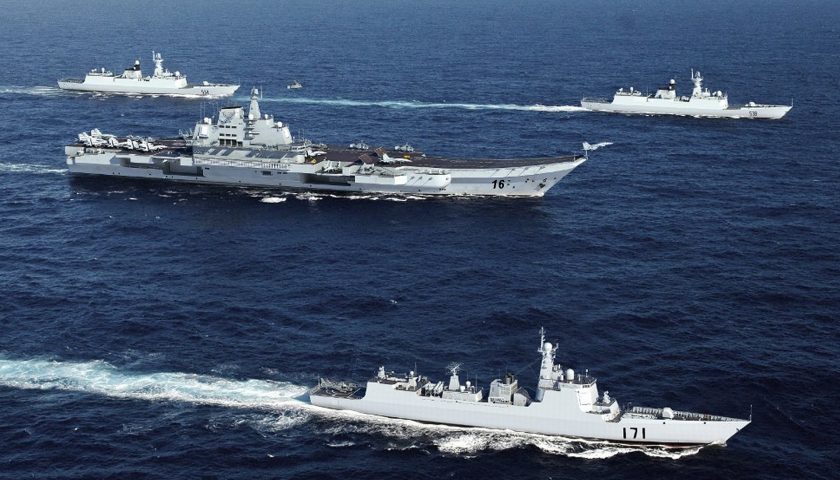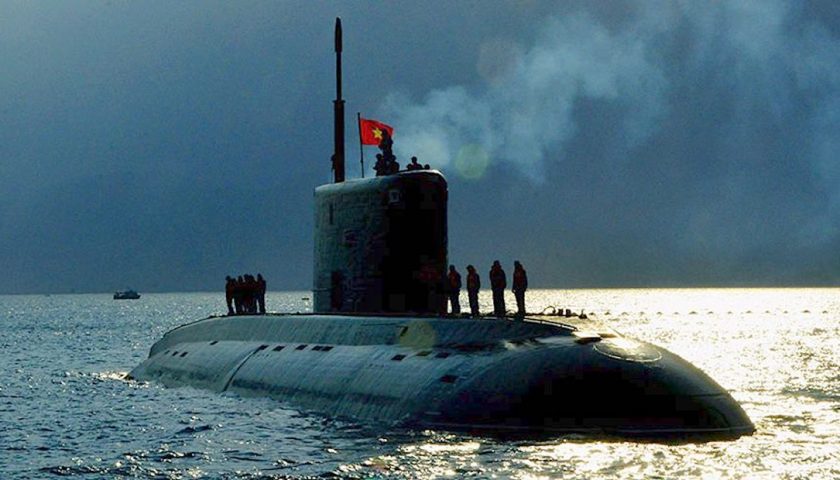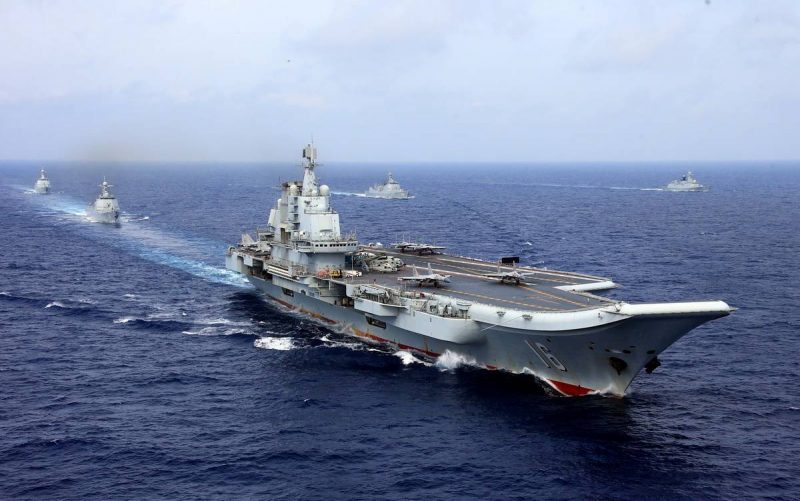Guest article by Noam Hakoun permanent full access
For the months of July and August 2021, the very influential journal Foreign Affairs wondered whether China could continuously grow.[1] It is indeed the inevitability of Beijing's growth that has haunted all American strategists since the intrusion of the Thucydides concept of Thucydides by Graham Allison in 2012.[2] Comparing the Chinese and American powers cannot be done without a fine analysis of the naval and maritime power relations. Because given the remoteness of the two powers and the geography of the region, a potential conflict between China and the United States will first arise on the seas. The observation of the Chinese fleet has therefore become a major concern of the American elites, and in the first place of the Congress.[3] and the Naval Intelligence Agency[4]. In this analysis, we will insist on the current limits of the rise of the Chinese navy.
But first, it is essential to affirm that the growth in terms of tonnage and modernization of Chinese naval equipment is undeniable. In 2005, the Chinese fleet numbered 216 ships (all categories combined), 75 less than the US Navy. The People's Army Navy also had no aircraft carriers, which were crucial in establishing its maritime domination in a key area. Between 2005 and 2020, the Chinese shipbuilding industry produced and supplied 117 ships. In 2020, the most serious estimates were therefore 333 ships for China, against 296 for the US Navy.[5] Of course, the Chinese navy did not fail to acquire two aircraft carriers, and to quadruple the number of ballistic missile submarines in its possession. Let us also add that the level of the Chinese navy is raising concerns even in France. During a hearing at the National Assembly, Admiral Vandier, current Chief of Staff of the Navy, admitted to having been surprised by the technical level and the current influence on the region of the Chinese Navy.[6] Remember, however, that no official information has been transmitted by the Chinese Communist Party, and that unlike the Western navies, the figures in this area are estimates.[7] The risk of strategic surprise is all the more increased.

While many IRSEM works[8] even non-specialist and mainstream newspapers[9] insisted on the meteoric rise of the Chinese navy, few French-speaking sources go into the details of Chinese shortcomings in this area. Because if any great geopolitical ambition cannot do without rearmament, it is not always a piece of cake and we will see what are the main geographical, technical and logistical challenges for the Chinese navy.
A strategic encirclement difficult to foil
As the famous geopolitologist Yves Lacoste wrote, geography is primarily used to wage war. However, for the moment this seems to be working against China; if the name China Sea suggests complete control over this maritime zone, the reality is much more complex. China claims the widest part of the China Sea stretching from the south of the Japanese archipelago to northern Indonesia and southeast of Vietnam, including of course Taiwan. Inside this first chain of islands, China occupies a quasi-hegemonic military position, among other things thanks to the military developments in the Spratly Islands that began in November 2016.[10]Beyond this zone, China is well and truly corseted by a powerful network of American naval bases stretching from South Korea to Singapore, via Japan. More substantial is the Guam naval base which partitions the second island chain. Furthermore, the Americans are not the only ones participating in this maneuver to “corset” Chinese naval ambitions. For example, the recent Japanese deployment of F-35 fighters on the Nansei Islands is significant. The absence of naval bases located in allied countries is a real shortcoming in Chinese maritime and naval policy, which Beijing must strive to fill to break this logic of encirclement.
If we go back in time, the concept of the first chain of islands was also thought of by American authors like Dulles or Kennan, with a view to limiting the expansion of communism in the midst of the war. Cold.[11] Thirty years after the Cold War, and fifty years after the Sino-American reconciliation of 1971, this chain of islands remains a straitjacket for Chinese strategists. Another historical reminder allows us to better understand the problem of surrounding China. When the Americans established their hegemony over the Caribbean Sea at the end of the XNUMXth century, they first had to dislodge the Spaniards. Once the Spanish influence was extinguished, there was no fleet left to oppose the US Navy. In our case, China will first have to deal with the United States, but also with other navies. Let us take only the example of Vietnam, a minor power.
Hanoi has a limited number of surface combatant ships, but has 35 fourth-generation Su-30 fighters, potentially armed with Kh-31 supersonic anti-ship missiles.[12] The Vietnamese Navy is also deploying six Kilo-class diesel submarines purchased from Russia over the past decade.[13] Added to this are advanced coastal anti-ship missile batteries, the Russian P-800s, which can strike targets up to 230 miles from the Vietnamese coast. In truth, these assets give Vietnam little chance against China in a sustained maritime conflict. But they create enough impact for Vietnam to hurt China or deter it. The sole example of Vietnam illustrates how far China's neighbors are from being in a situation of complete and total inferiority to China, as the Caribbean powers were to America at the end of the XNUMXth century. . Add to this equation the world's third largest economy, Japan, and a nuclear power, namely India.

So that the Chinese navy can leave the first chain of islands, and therefore leave its territorial waters, the Japanese Nansei Islands and the Philippines force it to use two relatively narrow exit routes: the Strait of Miyako in the north of Taiwan and the Bashi canal in the south of this island. This single observation makes it possible to understand the geostrategic importance of Taiwan which, being independent from China, creates the conditions for this bottleneck. Once back in the Chinese fold, Taiwan will offer Beijing a direct opening to the Pacific. All the debates around Taiwan can be summed up in this issue. If the Chinese Communist Party plays on the rhetoric of a unique and indivisible China, it is because the peoples, as always, prefer nationalist arguments to geostrategic considerations.
Geographically, Taiwan constrains China. Any Chinese prospectivist can easily assume that in the event of conflict, Taiwan would constitute an indispensable element of a potential blockade. Verbatim, the Silk Roads are also a means of countering this geographic and geopolitical suffocation of which Taiwan is the pillar.
If we look at the conditions offered to China from the south, the exit routes from the China Sea are mainly oriented towards the Indian Ocean, notably via the Singapore and Malacca Straits. This makes it difficult for China to send ships or submarines into the deep waters of the Philippine Sea and the broader Pacific without crossing these two distinct choke points.
The problem of shallow water
Another aspect of geography worth discussing here concerns the underwater features of the region. The three main bodies that make up the bulk of East Asia's littoral waters – the Yellow Sea, the East China Sea and the South China Sea – are all relatively shallow. This is especially true for the Yellow Sea, which has an average depth of only 200 to 260 feet.[14] The East China Sea has deep channels in close proximity to Japan, but its average depth is only 650 feet.[15] As for the South China Sea, it is deep in places, especially in the center, but in the south and over its entire perimeter (including the Chinese coast and the Taiwan Strait), it is also quite shallow.[16]

This is important because of the difficulties caused by shallow water for active and passive sonar.[17] Shallow depths can interfere with signal reflection and produce distortions, thereby blurring the underwater acoustic image of surface and submarine vessels. Detection, tracking, and targeting of underwater assets are negatively affected. The Chinese ability to guarantee an operational environment free of submarine threats is therefore doubtful, despite their recent investments in anti-submarine warfare vessels and the deployment of their own network of underwater sensors.[18]
Let us agree that American forces entering the waters mentioned above will face just as much of this challenge as Chinese forces. But American ships do not have to operate there specifically and permanently in the event of a conflict. Conversely, the various Chinese fleets, due to the location of their home ports and potentially their objective (for example, Taiwan), cannot avoid this problem. The need for control of the sea – both above and below the waves – is therefore more important to Chinese forces, especially if they were to attempt something as daring as an amphibious invasion of Taiwan or a another act of major maritime aggression.
[1] https://www.foreignaffairs.com/issues/2021/100/4
[2] https://eurasiaprospective.net/2020/06/19/13300/
[3] Congressional research Service – China Naval Modernization: Implications for US Navy Capabilities—Background and Issues for Congress
[4] https://www.oni.navy.mil/News/Naval-Capabilities/China/
[5] Congressional research Service – China Naval Modernization: Implications for US Navy Capabilities—Background and Issues for Congress – July 1, 2021
[6]http://www.opex360.com/2021/07/24/amiral-vandier-le-niveau-de-la-marine-chinoise-est-au-dela-de-ce-que-nous-imaginions/
[7] https://thediplomat.com/2019/02/predicting-the-chinese-navy-of-2030/
[8] https://www.irsem.fr/le-collimateur/la-vertigineuse-ascension-de-la-marine-chinoise-17-11-2020.html
[9]https://www.lepoint.fr/monde/comment-la-marine-chinoise-entre-dans-la-cour-des-grands-02-05-2021-2424567_24.php
[10] https://amti.csis.org/chinas-new-spratly-island-defenses/
[11] https://intpolicydigest.org/china-has-almost-breached-the-first-island-containment-chain/
[12] https://direct.mit.edu/isec/article/42/2/78/12177/The-Emerging-Military-Balance-in-East-Asia-How
[13] https://thediplomat.com/2016/02/vietnam-gets-fifth-submarine-from-russia/
[14] https://www.britannica.com/place/Yellow-Sea
[15] https://www.britannica.com/place/East-China-Sea
[16] https://www.britannica.com/place/South-China-Sea
[17] https://physicstoday.scitation.org/doi/10.1063/1.1825269
[18]https://www.fpri.org/article/2021/05/chinas-maritime-intelligence-surveillance-and-reconnaissance-capability-in-the-south-china-sea/

